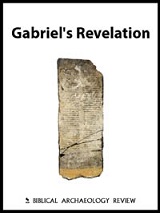The Lord bless you and keep you; the Lord make his face to shine upon you, and be gracious to you; the Lord lift up his countenance upon you, and give you peace.
—Numbers 6:24–26

When unrolled, the two ancient amulets from Ketef Hinnom revealed miniature writing that had been painstakingly inscribed on them. Researchers discovered that the inscriptions included blessings similar to Numbers 6:24–26. Photo: © Israel Museum, Jerusalem, by Nahum Slapak.
In 1979 during the excavation of a late Iron Age (seventh century B.C.E.) tomb at the funerary site of Ketef Hinnom outside of Jerusalem, archaeologist Gabriel Barkay uncovered two small silver scrolls—no bigger than the diameter of a quarter—that were originally worn as amulets around the neck. When researchers from the Israel Museum, Jerusalem, unrolled the sheets of silver, they detected tiny lines of the ancient Hebrew script inscribed on them. High-resolution photos of the miniature writing were taken in 1994 by the West Semitic Research Project at the University of Southern California, giving researchers the opportunity to study and decipher the Hebrew text on the ancient amulets. When they finally read the arcane writing, the researchers discovered that the inscriptions, dating to the eighth–sixth centuries B.C.E., contained blessings similar to Numbers 6:24–26.1
The essay writing on the silver scrolls was clearly not meant to be read—the letters are too small, and the writing was furthermore concealed inside the rolls. If this was the case, then what purpose did they serve? In “Words Unseen: The Power of Hidden Writing” in the January/February 2018 issue of Biblical Archaeology Review, Hebrew Bible scholar Jeremy D. Smoak discusses what these ancient amulets from Ketef Hinnom can tell us about religion in ancient Judah.
Upon discovery, Amulet 1 was 1 inch in height and 0.4 inches in diameter; unrolled, the scroll measures 3.8 inches in height and 1 inch in width. Amulet 2 was 0.5 inches in height and 0.2 inches in diameter; unrolled, the scroll has a height of 1.5 inches and a width of 0.4 inches. The second scroll contains about 100 words arranged in 12 lines of text—thus, the person who inscribed the text was able to fit all of that onto a silver sheet the length of a match stick.


Amulet 1 from Ketef Hinnom measured just 1 inch in height and 0.4 inches in diameter before it was unrolled. Photo: Zev Radovan/biblelandpictures.com.
In addition to containing blessings similar to Numbers 6:24–26, the inscriptions are illuminating for what they reveal about the deity Yahweh as well as amuletic magic in Iron Age Judah. As Smoak writes:
Amulet 1 refers to Yahweh as the one who shows graciousness to those who love him and keep his commandments. This expression exhibits close parallels to several Biblical texts (cf. Deuteronomy 7:9; Nehemiah 1:5; Daniel 9:4). Amulet 2 refers to Yahweh as the deity who has the power to expel Evil.
As the amulets from Ketef Hinnom contained small inscriptions that were not meant to be read, Smoak further considers in his article the significance of miniature writing:
Miniatures—especially those worn on the human body … create a sense of intimacy, privacy, and personal time between the body and the object. Such objects became part of one’s daily routine and lifecycle. Their lightweight quality allows them to dangle comfortably from necks, producing a feeling that they are part of the body. In the case of miniature texts on jewelry, this means that even though the writing might be invisible or hidden from eyes, the words are always accessible in the wearer’s mind as the writing interacts with the body on a physical level. As the jewelry dangles from, bounces off, and returns to the body, the words inscribed on their surfaces are replayed in the mind.
Read Jeremy D. Smoak’s complete analysis of the ancient amulets’ miniature writing in “Words Unseen: The Power of Hidden Writing” in the January/February 2018 issue of BAR, and discover what these unique artifacts illuminate about religion in Iron Age Judah.
Notes:
1. See Gabriel Barkay, “The Riches of Ketef Hinnom,” BAR, July/August September/October 2009.
More on ancient amulets in Bible History Daily:
https://ift.tt/3BKQWIU
Amulet with Cartouche of Thutmose III Discovered in Jerusalem
Get more biblical Archaeology: Become a Member
The world of the Bible is knowable. We can learn about the society where the ancient Israelites, and later Jesus and the Apostles, lived through the modern discoveries that provide us clues.
Biblical Archaeology Review is the guide on that fascinating journey. Here is your ticket to join us as we discover more and more about the biblical world and its people.
Each issue of Biblical Archaeology Review features lavishly illustrated and easy-to-understand articles such as:
• Fascinating finds from the Hebrew Bible and New Testament periods
• The latest scholarship by the world's greatest archaeologists and distinguished scholars
• Stunning color photographs, informative maps, and diagrams
• BAR's unique departments
• Reviews of the latest books on biblical archaeology
The BAS Digital Library includes:
• 45+ years of Biblical Archaeology Review
• 20+ years of Bible Review online, providing critical interpretations of biblical texts
• 8 years of Archaeology Odyssey online, exploring the ancient roots of the Western world in a scholarly and entertaining way,
• The New Encyclopedia of Archaeological Excavations in the Holy Land
• Video lectures from world-renowned experts.
• Access to 50+ curated Special Collections,
• Four highly acclaimed books, published in conjunction with the Smithsonian Institution: Aspects of Monotheism, Feminist Approaches to the Bible, The Rise of Ancient Israel and The Search for Jesus.
The All-Access membership pass is the way to get to know the Bible through biblical archaeology.
The post Miniature Writing on Ancient Amulets appeared first on Biblical Archaeology Society.

0 Commentaires